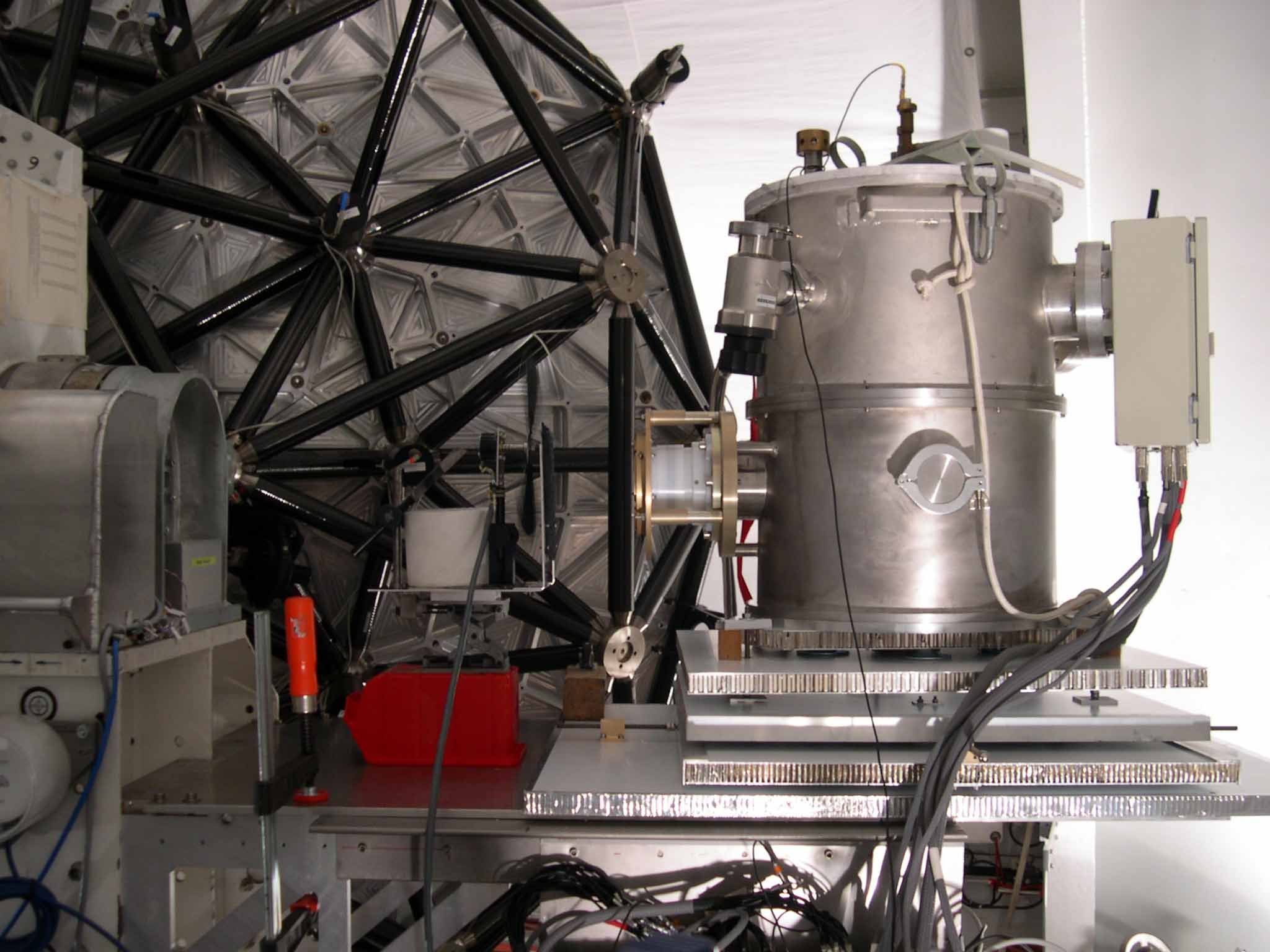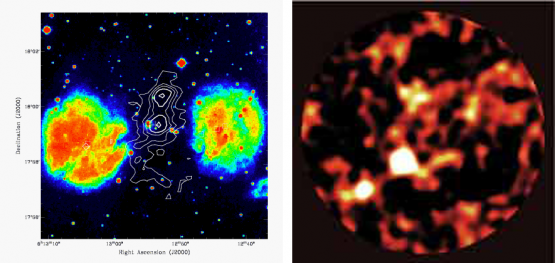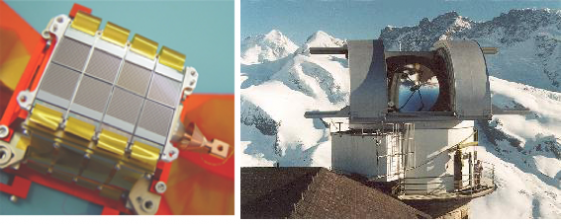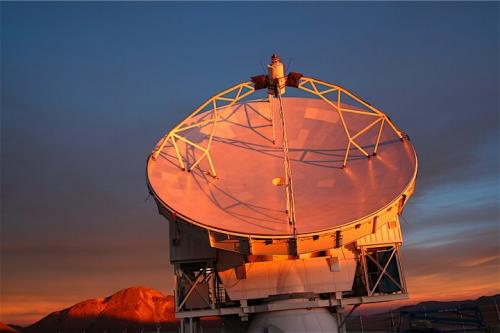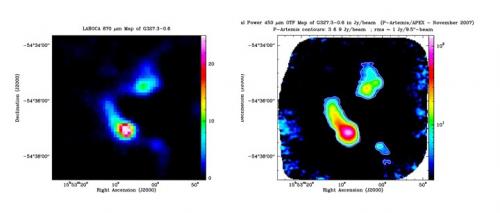The Artemis camera has been successfully installed on APEX telescope during the summer 2013. The new camera has already delivered a spectacularly detailed view of the Cat’s Paw Nebula.
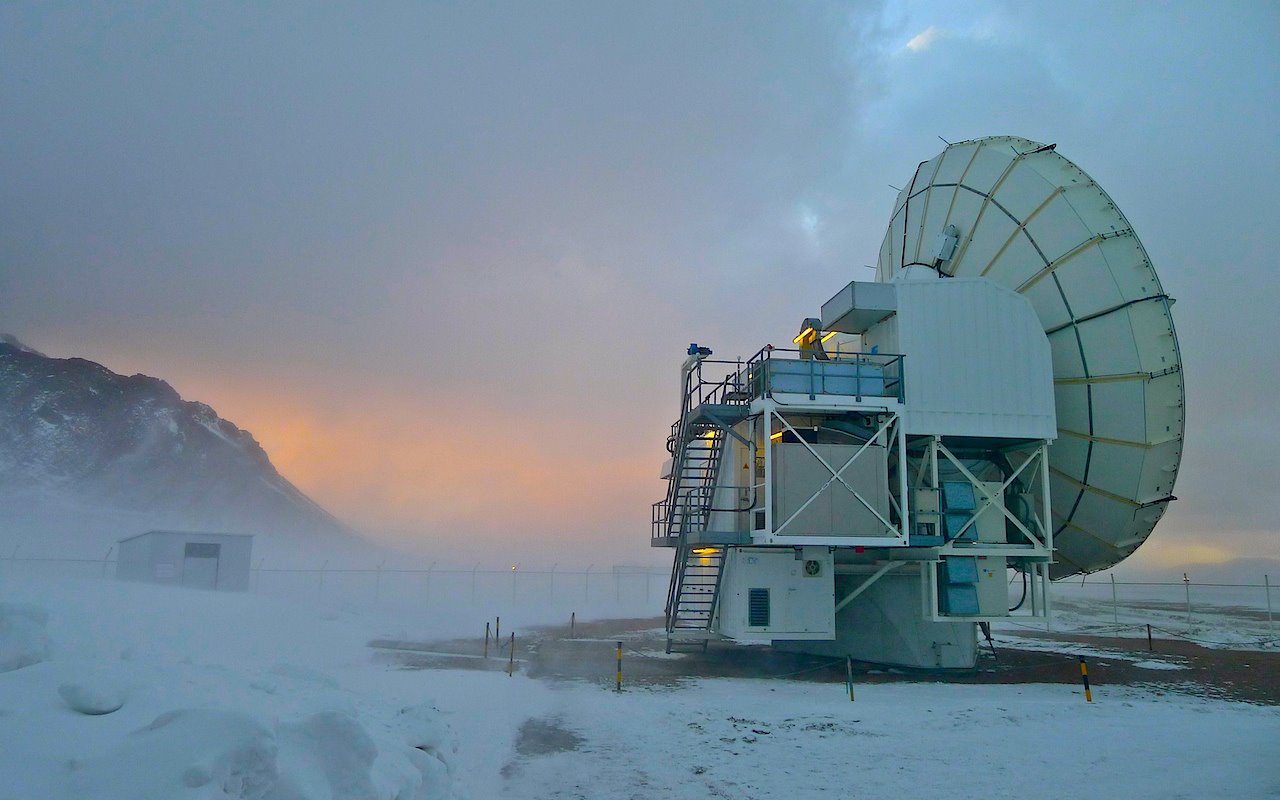
APEX telescope at 5100 m on Llano Chajnantor in Chile (Credit ESO).
The commissioning team that installed ArTeMIS had to battle against extreme weather conditions to complete the task. Very heavy snow on the Chajnantor Plateau had almost buried the APEX control building. With help from staff at the ALMA Operations Support Facility and APEX, the team transported the ArTeMiS boxes to the telescope via a makeshift road, avoiding the snowdrifts, and were able to install the instrument, manoeuvre the cryostat into position, and attach it in its final location.
Following the commissioning done at a wavelength of 350 microns, several scientific projects have already been observed. One of these targets was the star formation region NGC 6334, (the Cat’s Paw Nebula), in the southern constellation of Scorpius (The Scorpion). This new ArTeMiS image is significantly better than earlier APEX images of the same region.
The testing of ArTeMiS has been completed and the camera will now return to Saclay in France in order to install additional detectors in the instrument. The whole team is already very excited by the results from these initial observations, which are a wonderful reward for many years of hard work and could not have been achieved without the help and support of the APEX staff.
CEA teams involved in Artemis.
CEA-Irfu has received an ANR Grant (2006-2008) to initiate the Artemis project. All subsystems (cryogenics, optics, mechanics, control, electronics, software) have been designed, made and tested by CEA-Irfu and CEA/Inac.
The detectors used in the Artemis camera are bolometers designed and built by the CEA-LETI Institute in Grenoble.
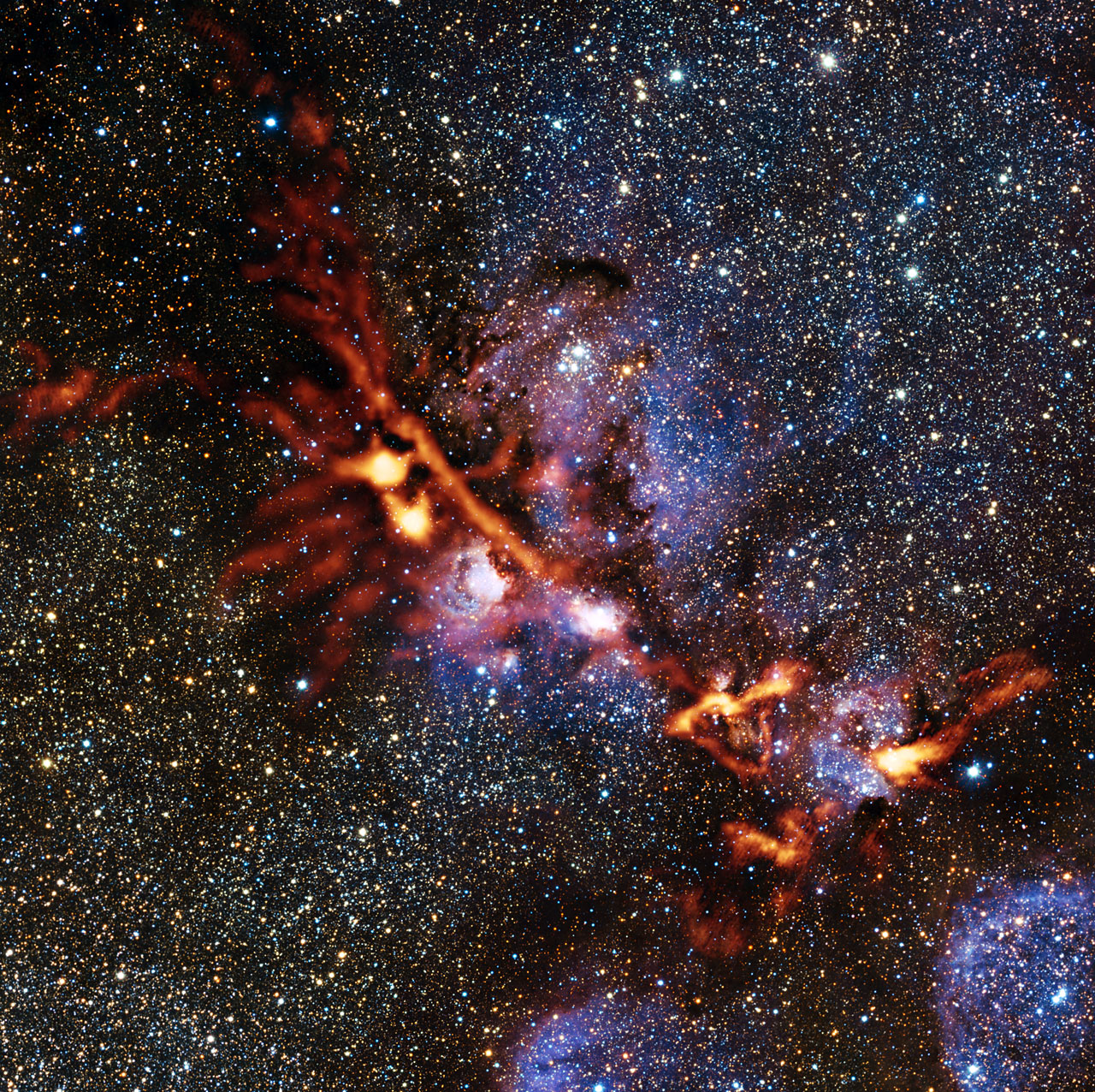
The star-forming Cat’s Paw Nebula through ArTeMiS’s eyes (Credit ESO).
Links :
First 450 micron imaging of star-forming regions and protoplanetary disks with p-ArTéMiS on APEX telescope
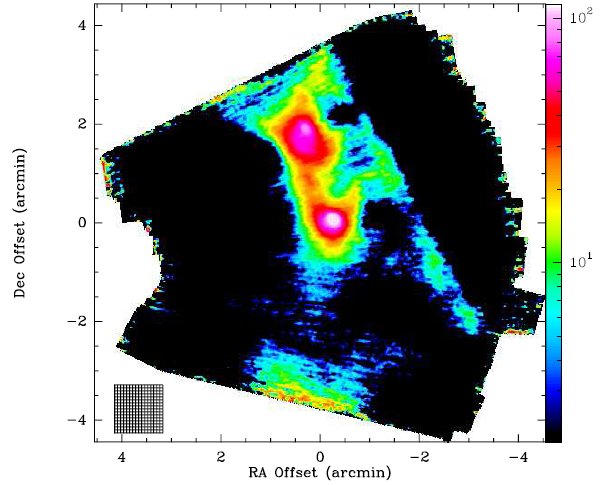
First image of NGC3576 at 450 microns, a Southern hemisphere region of high-mass star formation that is not observable with Northern telescopes.
The first wide-field maps were obtained with the prototype camera of ArTéMiS, a wide-field new generation bolometer camera, on APEX telescope on the Chajnantor plateau in Chile. These astronomical observations were carried out thanks to three ESO and Swedish time project on APEX. The Saclay astronomers have imaged the thermal emission of cold dust grains that are embedded in star-forming cores and in proto-planetary/deris. Among the imaged regions, NGC3576, G327.3-0.6, S255, NGC2264, high-mass star-forming regions, and HD97048 et Beta-Pictoris, a protoplanetary and a debris disks were mapped and detected. Figure in attachment present our large-scale map of NGC3576 at 450 microns.
Science objective
The ARTEMIS project aims to develop novel technologies for large arrays of detectors in the submillimetre part of the electromagnetic spectrum. These large array developments will mainly be beneficial for submillimetre astronomy and its needs in the coming years. The study of embedded star formation at all scales in the Universe will particularly benefit with two highlight projects on:
- the earliest phases of star formation: luminosity and mass of massive protostars.
- high redshift galaxies (z>3) and star formation in the early Universe.
Astronomical observations at submillimetre wavelengths are limited either by the angular resolution of the telescope or by the sensitivity and the field of view of the detector array. New generation of radio telescopes, such as the APEX telescope on the high altitude plateau of Atacama in Chile, can overcome these limitations if they are equipped with large detector arrays made of thousands of sensitive bolometer pixels.
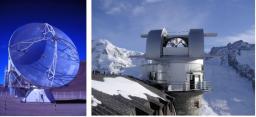
Left: APEX telescope at 5100 m on Llano Chajnantor in Chile. Right: KOSMA telescope at 3100 m on the Gornergrat in the Swiss Alps.
Telescope
A prototype of ArTéMiS has successfully been tested on the KOSMA telescope from University of Cologne and on APEX (MPIfR/Bonn, Onsala Space Observatory/Sweden, ESO), a 12-m ALMA type telescope on Llano Chajnantor in Chile. First Astronomical observations at 450 µm with p-ArTéMiS/APEX in the continuum were carried out in November 2007 under ESO and Swedish observing time.
Project funding and consortium
The ArTéMiS project is funded by the French Research Agengy (ANR), the CEA, and partly by two national programmes, PNPS and PCMI. ArTéMiS is CEA led-collaboration with IAS/CNRS, IAP/CNRS and CRTBT/CNRS. Our international partners are Onsala Space Observatory/Sweden, ESO, and KOSMA/University of Cologne. Contributions from CEA/DRT/Leti, CEA/DSM/SBT and CEA/DSM/SIS are also acknowledged.
First lights of the ArTéMiS prototype camera (p-ArTéMiS)
March 2007: First lights on the APEX telescope and p-ArTéMiS as PI instrument on APEX.
March 2006: First lights on the KOSMA telescope
Last update: 13/10/2008
Editor: V. Minier
The ARTEMIS project aims to develop novel technologies for large arrays of detectors in the submillimetre part of the electromagnetic spectrum. These large array developments will mainly be beneficial for submillimetre astronomy and its needs in the coming years. The study of embedded star formation at all scales in the Universe will particularly benefit with two highlight projects on:
- the earliest phases of star formation: luminosity and mass of massive protostars.
- high redshift galaxies (z>3) and star formation in the early Universe.
Astronomical observations at submillimetre wavelengths are limited either by the angular resolution of the telescope or by the sensitivity and the field of view of the detector array. New generation of radio telescopes, such as the ALMA-type antennas on the high altitude plateau of Atacama in Chile, can overcome these limitations if they are equipped with large detector arrays made of thousands of sensitive bolometer pixels.
Instrumentation developments undertaken at CEA and based on the all silicon technology of CEA/LETI/LIR are able to provide such large detector arrays. The ARTEMIS project consists in building a camera for ground-based telescopes that operates in two sets of atmospheric windows at 200-450 μm and 800-1200 μm. ARTEMIS-1 will be the detector operating in the atmospheric windows between 200 and 450 μm. Its focal plane will consist of filled bolometer array similar to those developed for the Herschel Space Observatory, an ESA mission satellite in which CEA is strongly involved. A prototype camera operating in the first set of atmospheric windows will be installed and tested in 2006 on the KOSMA telescope at Gornergrat (Switzerland) in collaboration with the German team from University of Cologne. From 2007, this prototype camera will be installed in collaboration with the Japanese team from University of Nagoya on the NANTEN-2 telescope located at the Chajnantor site in Chile. ARTEMIS-2 will be the detector operating in the atmospheric windows between 800 and 1200 μm. Its focal plane will consist of filled antenna-coupled bolometer arrays that will be designed based on technology developments made by both CNRS/CRTBT within the national programme DCMB and CEA/LETI. A prototype camera operating in this second set of atmospheric windows will be tested in 2007 on the KOSMA telescope.
By the end of project, the complete ARTEMIS camera could be operated on the APEX-12m telescope in Chile to provide scientific data to the community. ARTEMIS will then open new scientific prospects in the study of the early phases of star formation and in cosmology, in the study of the formation of large structures in the Universe.
The first wide-field maps were obtained with the prototype camera of ArTéMiS, a wide-field new generation bolometer camera, on APEX telescope on the Chajnantor plateau in Chile. These astronomical observations were carried out thanks to three ESO and Swedish time project on APEX. The Saclay astronomers have imaged the thermal emission of cold dust grains that are embedded in star-forming cores and in proto-planetary/deris. Among the imaged regions, NGC3576, G327.3-0.6, S255, NGC2264, high-mass star-forming regions, and HD97048 et Beta-Pictoris, a protoplanetary and a debris disks were mapped and detected.
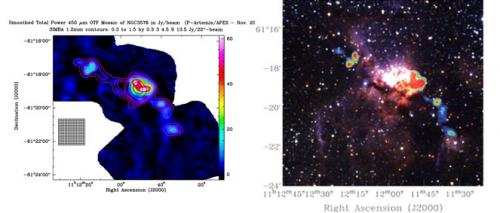
NGC3576. Left: 450-µm dust continuum emission image with p-ArTéMiS and 1.2-mm contour overlaid. The angular size of p-ArTéMiS filled bolometer array is shown. 450-µm observations resolve the 1.2 mm emission in massive clumps in which high-mass stars currently form. Right: Near-infrared image with 450-µm image overlaid. The bright central region harbour a cluster of young stars and a HII region. 450-µm emission arises from the edge of HII region as well as from adjacent 'dark', reservoirs of cold gas.
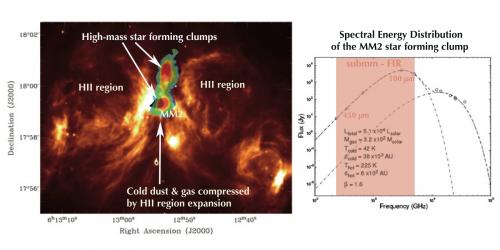
S255. Left: Spitzer IRAC image of thermal dust emission and PAH emission around HII regions. The RGB image overlaid on the Spitzer image is the cold dust emission from star-forming clumps as detected by the p-ArTeMiS bolometer array on APEX at 450 µm. Right: SED diagram of one of the star-forming clump that is built with dust emission from 1 mm to 8 µm. The cold component is mainly constrained by the submm/FIR emission of dust that allows to estimate the luminosity and dust temperature, and therefore deduces the clump mass. Each clump is a progenitor of a star cluster or high-mass protocluster
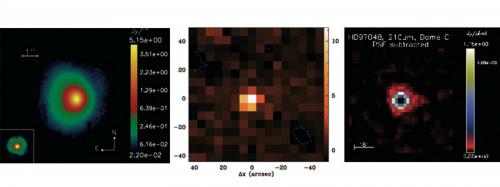
HD97048. Left: VLT/VISIR image of the HD97048 protoplanetary disk at 8.6 µm, showing its flared, extended surface (Lagage et al. 2006). The lower left inset is the VLT/VISIR PSF as a comparison. Middle: Observation of HD97048 with p-ArTeMiS/APEX at 450-µm with a pixel of 6''. Right: the HD97048 emission at 200 µm has been simulated using a radiative transfer code. A scaled PSF observation has been removed, showing that the disk image is resolved at 200 µm. This shows the potential to constrain the outer disk radius, which is very difficult to determine in the mid-infrared because of the lack of sensitivities to very cold dust.
This table sums up the expected (Artemis - 5760 bolometer pixels) and measured (P-Artemis - 256 bolometer pixels) performances of the instrument.
| Instrument |
Wavelength |
FOV |
Beam |
Pixel |
NEFDa |
Relative |
| ArTéMiS/APEX |
200 350+450d |
0.9'x1.0' 4.1'x2.3' |
4.2'' 9.4'' |
1.7'' 3.9'' |
(3000)c 800 (400) |
(0.3) 12 (27)d |
| P-ArTéMiS/APEX |
200 |
0.5'x0.5' |
4.2'' |
1.7'' |
(7500) |
(0.01) |
| SABOCA | 350 | 1.2'f | 7.3'' | 12'' | (350)g | (1)g |
| SHARC-2 | 350 | 2.6'x1.0' | 8.5'' | 4.8'' | 1000 | 1 |
| SCUBA-2 | 450 | 7.4'x7.4' | 7.5'' | 6.2'' | (500)h |
(20)h |
| LABOCA-1 | 870 | 11.4'f | 18.2'' | 30'' | 120 | 50 |
(a) Expected NEFD performance per detector assuming an elevation of 50° and PWV = 0.6 mm for 450 µm and 350 µm observations, which occurs 25% of the winter time at APEX; the quoted NEFD values at 200 µm assume PWV = 0.2 mm (i.e., best 10% winter conditions at the APEX site). The numbers given in parentheses represent goals that should be achieved after a full understanding of the instruments, while the other values represent sensitivities which either have already been achieved or can be achieved after commissioning, scaling from the successful results of P-ArTéMiS in November 2007.
(b) Imaging speed relative to SHARC-2 on the CSO at 350 µm for mapping cold dust emission. This is defined as the speed at which areas of the sky can be imaged (at full resolution) to a given equivalent surface brightness sensitivity. The wavelength normalization assumes a dust temperature Td= 15 K and a dust emissivity index ß=1.5 (local Universe), equivalent to Td=48 K, ß= 1.5 at a redshift z~2.2 typical of submillimeter galaxies (high-z Universe).
(c) Under the best 10% winter conditions at the APEX site (PWV = 0.2 mm).
(d) The 350+450 µm row gives the estimated performance of ArTéMiS after co-adding the data taken with the 350 µm and 450 µm arrays.
(e) P-ArTéMiS has a typical detector NEP~4.5x10-16 W/Hz0.5, i.e., a factor of ~3 worse than the PACS arrays, as this prototype uses ''free'' arrays not selected for Herschel. ArTéMiS will use optimized arrays with detector NEPs comparable to PACS, i.e., ~1.5x10-16 W/Hz0.5 (Billot et al. 2006).
(f) The field of views of SABOCA and LABOCA-1 are not instantaneously sampled: observing a minimum of 16 positions is required to obtain a fully-sampled image.
(g) Under the same conditions assumed for ArTéMiS at 350 µm, i.e., PWV = 0.6 mm, which occurs ~25% of the winter time at APEX.
(h) Under PWV<=0.9 mm which occurs ~25% of the winter time at Mauna Kea.
Last update: 02/04/2008 (V. Minier)
• Innovation for detection systems › Detectors for both infinite physics Structure and evolution of the Universe › Planets, star's formation and dynamics, interstellar medium Structure and evolution of celestial bodies
• The Astrophysics Division (DAp) • The Systems Engineering Division
• Cosmology and Galaxy Evolution group (LCEG) • Laboratory Star Formation and Interstellar Medium

